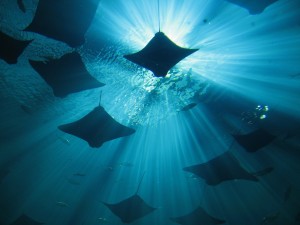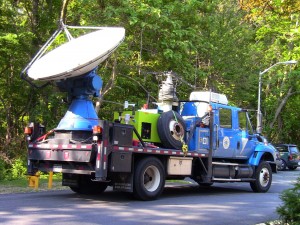The third “Sharknado” film premiers tonight on the SyFy channel, and early reviews suggest a similar level of insanity as has been present in the past two films. While the film suspends belief in as many scenes as possible, there is some accuracy in the science. Research currently being conducted at the School of Marine and Atmospheric Sciences at Stony Brook University examines some of the individual elements surrounding a sharknado.
Sam Urmy, a PhD candidate in Marine Sciences in Dr. Joe Warren‘s Acoustic Laboratory for Ecological Studies (ALES), studies the foraging movements of common terns in the waters around Great Gull Island in Long Island Sound using a small radar to track the birds as they fly over the water. He notes that:
“Doppler radars can and do detect a variety of animals in the atmosphere, including birds, bats, and insects. In fact, the national network of weather radars can be quite useful for biologists studying bird migrations and insect hatches (for instance, mayflies in the upper Midwest). The echoes generated by animals can be quite different from those generated by rain and hail. Objects much smaller than the length of the radar waves, like raindrops and small insects, scatter energy equally in all directions. Larger objects, like birds, create more complex echoes, which depend on which part of the bird is towards the radar, and even whether the the bird’s wings are flapping up or down.”
Atmospheric Science Ph.D. student Sara Ganetis, who studies the dynamics and predictability of precipitation structures within East Coast extratropical cyclones in Dr. Brian Colle‘s lab, highlighted a few important features of tornadoes, including what they are missing. “The lack of moisture…in the funnel (wouldn’t) be anywhere near adequate” for the shark, an animal that requires water to survive. She also warns of the most important threat to the shark: the additional debris that would be sucked up in the funnel and flying through the air along with the shark. “They’d get diced.”

Cownose rays swarming at the Georgia Aquarium (from Wikipedia)
Ph.D. student Andrew Fields, who works in shark expert Dr. Demian Chapman‘s lab, addressed the swarming nature of the sharks in the film. In the film, the tornado consumes swarms of various sharks, which remain in the vortex until they can be released on their victims. Fields notes that “elasmobranch swarms have been reported in multiple ocean environments,” and “cownose rays have been seen gathering and sweeping the ocean in numbers reported to be as high as 10,000 strong.” Fields added that in addition to the rays, “many shark species have been seen to swarm in large numbers including hammerheads, sandbar sharks and even the biggest fish of them all, the whale shark.” White sharks, like those that feature prominently in the film, “aggregate in certain areas (i.e. South Africa) during certain times of the year, but,” he explains, that behavior isn’t “considered swarming.”
Newly hired SoMAS Atmospheric Science professor Dr. Michael French, whose research focus includes supercell and tornado dynamics, Doppler weather radar applications and mesoscale meteorology, concludes the discussion with the following commentary:
“While many of us are likely to have nightmares about the entire East Coast being devastated by a bevy of maniacal sharks after watching Sharknado 3: Oh Hell No!, the reality is that most waterspouts are weak compared to tornadoes that we see inflict great damage across the country. Visual sightings of tornadoes, and now dual-polarization radar, have allowed us to document the lofting of objects by strong tornadoes, and we often hear anecdotal stories of light debris, like checkbooks or mail, being carried hundreds of miles. However, the weaker nature of waterspouts means their central updrafts are not able to loft heavy objects, like sharks, very high into the atmosphere, if at all. In addition, as we recently saw in Cape Cod, when a shark is out of water, it is probably focused on not dying and is not terribly interested in flying through the air and consuming you. While I cannot guarantee that you will not fall victim to a mass tornado-induced shark attack, I feel comfortable in saying there are other, more likely catastrophic risks to your well-being that should keep you up at night.”
What Dr. French does not indicate is what those insomnia-inducing catastrophic risks might be…





